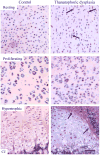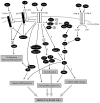Sixteen years and counting: the current understanding of fibroblast growth factor receptor 3 (FGFR3) signaling in skeletal dysplasias
- PMID: 22045636
- PMCID: PMC3240715
- DOI: 10.1002/humu.21636
Sixteen years and counting: the current understanding of fibroblast growth factor receptor 3 (FGFR3) signaling in skeletal dysplasias
Abstract
In 1994, the field of bone biology was significantly advanced by the discovery that activating mutations in the fibroblast growth factor receptor 3 (FGFR3) receptor tyrosine kinase (TK) account for the common genetic form of dwarfism in humans, achondroplasia (ACH). Other conditions soon followed, with the list of human disorders caused by FGFR3 mutations now reaching at least 10. An array of vastly different diagnoses is caused by similar mutations in FGFR3, including syndromes affecting skeletal development (hypochondroplasia [HCH], ACH, thanatophoric dysplasia [TD]), skin (epidermal nevi, seborrhaeic keratosis, acanthosis nigricans), and cancer (multiple myeloma [MM], prostate and bladder carcinoma, seminoma). Despite many years of research, several aspects of FGFR3 function in disease remain obscure or controversial. As FGFR3-related skeletal dysplasias are caused by growth attenuation of the cartilage, chondrocytes appear to be unique in their response to FGFR3 activation. However, the reasons why FGFR3 inhibits chondrocyte growth while causing excessive cellular proliferation in cancer are not clear. Likewise, the full spectrum of molecular events by which FGFR3 mediates its signaling is just beginning to emerge. This article describes the challenging journey to unravel the mechanisms of FGFR3 function in skeletal dysplasias, the extraordinary cellular manifestations of FGFR3 signaling in chondrocytes, and finally, the progress toward therapy for ACH and cancer.
© 2011 Wiley Periodicals, Inc.
Figures



References
-
- Aikawa T, Segre GV, Lee K. Fibroblast growth factor inhibits chondrocytic growth through induction of p21 and subsequent inactivation of cyclin E-Cdk2. J Biol Chem. 2001;276:29347–52. - PubMed
-
- Aviezer D, Golembo M, Yayon A. Fibroblast growth factor receptor-3 as a therapeutic target for achondroplasia-genetic short limbed dwarfism. Curr Drug Targets. 2003;4:353–65. - PubMed
-
- Avivi A, Zimmer Y, Yayon A, Yarden Y, Givol D. Flg-2, a new member of the family of fibroblast growth factor receptors. Oncogene. 1991;6:1089–92. - PubMed
-
- Bartels CF, Bukulmez H, Padayatti P, Rhee DK, van Ravenswaaij-Arts C, Pauli RM, Mundlos S, Chitayat D, Shih LY, Al-Gazali LI, et al. Mutations in the transmembrane natriuretic peptide receptor NPR-B impair skeletal growth and cause acromesomelic dysplasia, type Maroteaux. Am J Hum Genet. 2004;75:27–34. - PMC - PubMed
-
- Batlle E, Sancho E, Franci C, Dominguez D, Monfar M, Baulida J, Garcia De Herreros A. The transcription factor snail is a repressor of E-cadherin gene expression in epithelial tumour cells. Nat Cell Biol. 2000;2:84–9. - PubMed
Publication types
MeSH terms
Substances
Grants and funding
LinkOut - more resources
Full Text Sources
Other Literature Sources
Medical
Research Materials
Miscellaneous

